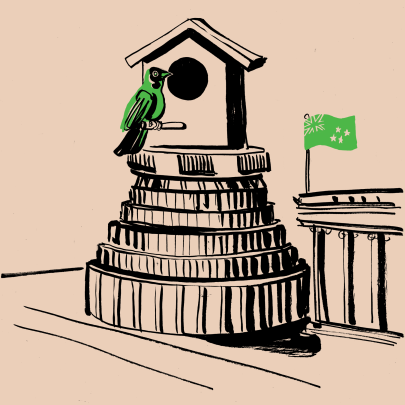Apr 6, 2023 Politics
The day Jacinda Ardern resigned, the sobs of performative liberals and real-groovy baby boomers in Wellington, and its over-privileged redoubts in Grey Lynn and Pt Chev, were heard most loudly by the Guardian in Kings Place and MSNBC in Rockefeller Plaza. More muffled, but just as out of touch, were the whoops and high fives of National’s Wellington-based staffers, equally sure the election was now decided.
In the real world, anyone in touch with mainstream Auckland sentiment since the long 2021 lockdown — or even just able to read a poll — knew Ardern’s departure was the launch of Labour’s comeback. Within days, the weather played its part to position Prime Minister Chris Hipkins as national leader. The National Party has been in denial ever since. Its untreated political ADHD continues, as it barks excitedly at a passing car only to be distracted by another.
Unlike the politician herself, Ardern’s most devout followers never understood how unpopular she had become. After the lockdown in 2021, Ardern began 2022 with a net favourability only slightly ahead of that of Christopher Luxon, National’s new leader. By mid-year, Luxon was down around zero, never to recover.
In turn, Ardern — unable to exude the new sleeves-rolled-up Ms-Fix-It brand designed for her — spent the year chasing Luxon south. By January 2023, according to the monthly Taxpayers’ Union-Curia poll, both were at -1% net favourability. The same poll had Labour trailing National 32% to 37% and the Labour-Green-Māori Party bloc behind National-Act 44% to 48%. The numbers were broadly replicated in another reputable poll.
Hipkins’ accession changed everything. In early February, the Taxpayers’ Union-Curia poll had Hipkins on +27% net favourability — higher than Ardern had ever been in 2022 — and with Luxon down further to -5%.
Like John Key’s in 2016, Ardern’s judgement of her party’s prospects under new management proved correct, and nobody should be surprised. If there is anything on which the most swivel-eyed Jacindamaniac and the most deranged Groundswell misogynist agree, it is that Ardern, like Key, is world-class at reading the public mood. Both have exponentially greater self-awareness and emotional intelligence than their party hacks. At least so far, Ardern has done even better than Key at disappearing into the background and allowing her successor to shine. Meanwhile, Luxon comes across as a second-rate Key — a brand Key himself judged had run its course six years ago.
The best parallel is when Margaret Thatcher was replaced by John Major, leaving both Thatcher-ultras and UK Labour certain the humdrum Neil Kinnock had the next election in the bag.
As Hipkins was to Ardern, Major was one of Thatcher’s chief lieutenants, having served as her foreign secretary and chancellor of the exchequer, the way Hipkins was Ardern’s public service, education, health, Covid-19 and police minister, as well as her leader of the House. As successors, that meant both Major and Hipkins were sufficiently similar to represent continuity.
But those similarities only disguised the differences necessary to put their parties back in the running. Gender could be one. More likely is that both Thatcher and Ardern had become truly global figures, with utterly besotted fans domestically and internationally, distorting media perceptions. If Thatcher wins the trophy for delivering more of her agenda, Ardern gets the cup for not going mad with power and needing to be deposed, instead writing her own departure.
Major and Hipkins could therefore position themselves as more down-to-earth than their stellar predecessors — less interested in being photographed with Mikhail Gorbachev or King Charles, and more focused on voters.
Moreover, with exceptions like the poll tax, voters mostly liked Thatcher’s policy direction but had become sick of her style. The same was true of Ardern. Change the style and get rid of the exceptions and watch the polls turn back to the incumbent.
The Auckland floods and Cyclone Gabrielle then gave Hipkins the chance to show leadership in a crisis — the way Major could with the 1991 Gulf War, Ardern had with the Christchurch masjidain attacks in March 2019 and Covid in March 2020, Key with the Christchurch earthquake in February 2011, and even Bill English when he became prime minister in 2016 a month after the Kaikōura quake.
Policy-wise, Key, English, Ardern and Hipkins all followed broadly the same crisis approach, with Minister of Cyclone Recovery Grant Robertson talking openly of the model left by Key and English when meeting business groups.
But Hipkins’ personal style is his own. He can’t visually emote like Ardern, and to a lesser extent Key. His manner is closer to English’s — certainly concerned, but less demonstrative and more interested in practical matters than securing the best camera shot. He and Robertson wear jeans and NEMA jackets rather than suits and ties. Sometimes they even look a bit sloppy, like most Kiwi dads on a weekend.
This is stage-managed, of course. But it’s not inauthentic. Happily for Labour, it also coincides with what market research has suggested for over a year that median voters want. Right now, authenticity and direct talk are in. Gush and slogans are out.
National complains the floods and cyclone stopped it launching 2023 as planned. But, when Luxon finally gave his State of the Nation speech in early March, it didn’t contain much except handouts to parents of kids in early childhood education centres, capped at $75 a
week per household.
National claimed to have worked on the policy for months, but the self-proclaimed party of business hadn’t considered whether the $75 would be inflated away by early childhood centres raising their prices, the way Labour’s $50-a-week rent subsidy for students was captured entirely by landlords. Critics asked whether the policy was really designed to help families with under-fives or the private-equity funds that mostly own early childhood centres.
Less than seven months before election day, buy some cover for that punt you placed on National before Christmas — or place a fresh bet on Labour. Unless the economic storm this winter is as bad as the rain through summer, the blue team is heading for a third defeat.
–






